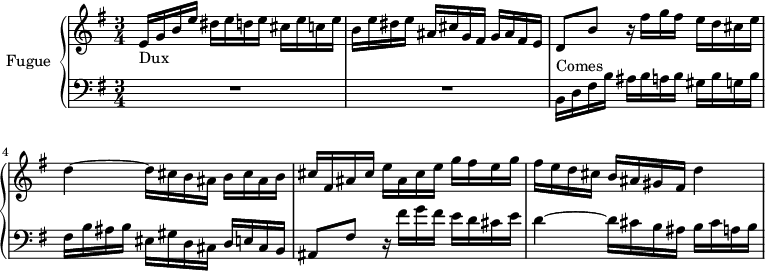Prelude and Fugue in E minor, BWV 855, is the 10th prelude and fugue for keyboard (harpsichord) in the first book of The Well Tempered Clavier, composed in 1722 by Johann Sebastian Bach. [1] The Prelude in E minor, BWV 855a, features as No. 18 ("Praeludium 5") in the 1720 Klavierbüchlein für Wilhelm Friedemann Bach. BWV 855a may also refer to both this Prelude and a Fughetta in the same key, an early version of BWV 855. Alexander Siloti made a piano arrangement in B minor of the Prelude BWV 855a.
Prelude and Fughetta, BWV 855a
Where the 1998 version of the Bach-Werke-Verzeichnis (BWV2a) described BWV 855a as only a Prelude, based on its appearance in the Klavierbüchlein für Wilhelm Friedemann Bach, [2] BWV 855a may also refer to both this Prelude and a Fughetta in E minor, found in a manuscript copy made between 1750 and the early 19th century, once owned by F. Konwitschny but later lost. The Prelude and Fughetta were published in Series V, Volume 6.1 of the Neue Bach-Ausgabe, based on various sources for the Prelude, and on the Konwitschny source (of which a film copy had been preserved) for the Fughetta. [3] BWV 855a is an early version of BWV 855, No. 10 in the 1722 first book of the Well-Tempered Clavier. [4]

Prelude and Fugue, BWV 855, No. 10 of The Well Tempered Clavier, Book I
This piece was written for harpsichord by Bach in 1722 or earlier. [5]

Prelude
There are 41 measures. The bass line is made up of running sixteenth notes throughout. The treble line is made up of running sixteenth notes throughout with mixed notes in between. [6]
![\version "2.18.2"
\header {
tagline = ##f
}
upper = \relative c'' {
\clef treble
\key e \minor
\time 4/4
\tempo 4 = 63
\set Staff.midiInstrument = #"harpsichord"
%% PRÉLUDE CBT I-10, BWV 855, mi mineur
<< { e2~ e8 fis32 e dis e e8.\prall dis32 e | fis1~ | fis16 e dis e fis e g fis a4~ a32 c b a g16 a32 fis g2~ g8 c16 b c8 e, fis2~ fis8 b~ b32[[ c b a] b[ g a b]] e,8~ } \\ { \repeat unfold 2 { g,8 r8 r4 } \repeat unfold 3 { a8 r8 r4 } b8 r8 r4 \repeat unfold 2 { b8 r8 r4 } a8 r8 r4 b8 r8 r4 g8 } \\ { \repeat unfold 2 { b8 s8 s4 } \repeat unfold 3 { c8 s8 s4 } fis8 s8 s4 \repeat unfold 2 { e8 s8 s4 } c8 s8 s4 d8 s8 s4 b8 } >>
}
lower = \relative c {
\clef bass
\key e \minor
\time 4/4
\set Staff.midiInstrument = #"harpsichord"
\repeat unfold 2 { e16 g a b a b a g }
\repeat unfold 2 { e16 a b c b c b a }
\repeat unfold 2 { dis,16 a' b c b c b a }
\repeat unfold 2 { e16 g a b a b a g }
e16 fis g a g a g fis d fis g a g a g fis d16
}
\score {
\new PianoStaff <<
\set PianoStaff.instrumentName = #"Prelude"
\new Staff = "upper" \upper
\new Staff = "lower" \lower
>>
\layout {
\context {
\Score
\remove "Metronome_mark_engraver"
\override SpacingSpanner.common-shortest-duration = #(ly:make-moment 1/3)
}
}
\midi { }
}](https://upload.wikimedia.org/score/o/4/o4wkmf9q2ktqlhyqk3pwqj3br2cw5q1/o4wkmf9q.png)
Fugue
The fugue is in 2 voices and there are 42 measures. [7]

Siloti's arrangement of BWV 855a: Prelude in B minor
Alexander Siloti made an arrangement the Prelude BWV 855a for piano, transposing it to B minor:

This arrangement has been described as "perhaps Siloti's most tender and perfect" transcription. [8] It transposes Bach's original down from the original E minor into B minor, with the steady sixteenth note figuration that was originally given by Bach to the left hand being instead assigned to the right hand. Siloti also adds a repeat of the entire work, in order to allow for a change of voicing where the melody in the left hand is emphasized. [8] In the published score, above, the chords in the left hand are arpeggiated; however, according to Siloti's daughter Kyriena (to whom the work was dedicated [8]), he would omit the arpeggiation on the first pass and restore it on the repeat in order to heighten the effect of the left-hand melody. [8] It has been performed by many pianists, most famously Emil Gilels. [8]
The date of the arrangement is uncertain: it was first published by A. Gutheil of Moscow, [9] and was performed by Siloti in public for the "first time" (according to an announcement in the Manchester Guardian) in February 1912. [10]
References
- ^ Work 01004 at Bach Digital website
- ^ (BWV2a) Alfred Dürr, Yoshitake Kobayashi (eds.), Kirsten Beißwenger. Bach Werke Verzeichnis: Kleine Ausgabe, nach der von Wolfgang Schmieder vorgelegten 2. Ausgabe. Preface in English and German. Wiesbaden: Breitkopf & Härtel, 1998. ISBN 3765102490 - ISBN 978-3765102493. pp. 375–376
- ^ Alfred Dürr, editor. Das Wohltemperierte Klavier I (NBA V/6.1), Bärenreiter, 1989. pp. 170–173 ( Critical commentary p. 340)
-
^ Bach Digital Work No.
01005 at
www
.bachdigital .de - ^ "The Well-Tempered Clavier I No. 10 in E Minor". Netherlands Bach Society. Retrieved April 23, 2021.
- ^ BWV 855 The Well-Tempered Clavier Part I Praeludium X at MuseScore website
- ^ BWV 855 The Well-Tempered Clavier Part I Fuga X at MuseScore website
- ^ a b c d e Barber, Charles (2004), "The Transcriptions", The Alexander Siloti Collection: Editions, Transcriptions and Arrangements for Piano Solo, Carl Fischer, L.L.C., pp. 11–13, ISBN 0-8258-4730-3
- ^ Barber, Charles (2002). Lost in the Stars: The Forgotten Musical Life of Alexander Siloti. Lanham, MD: Scarecrow Press. p. 369. ISBN 9780810841086.
- ^ "The Hallé Concerts: Fifty Fourth Season, 1911–12: Eighteenth Concert Thursday Next [advertisement]". Manchester Guardian (20454): 1. 1912-02-27.
